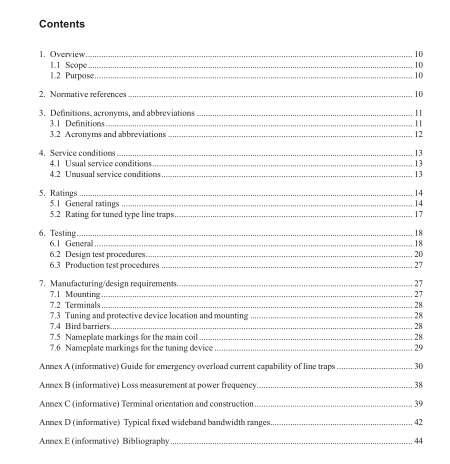IEEE C93.3-2017 pdf download.IEEE Standard Requirements for Power-Line Carrier Line Traps (30 kHz to 500 kHz)
For a field adjustable wideband line trap. the rated minimum blocking impedance shall be 4000.6000, 10000.01 configured In sty of these inpedances as agreed between the manufacturer aid purchaser.
For a factors fixed wideband line trap, the rated minimum blocking impedance shall be 4000, 600 U. or
10(N) U.
3.2.4 VariatIon of blocking characteristics with change in ambient temperature and change In continuous current
5.2.4.1 Single- and two-frequency tuning
The resonant frequency shall not vary more than a total of 2% for changes in both the ambient temperature and the continuous current within the temperaiure range of—k) ‘C to —45 ‘C and from zero to rated continuous current.
3.2.4.2 Wide band tuning
For the uield.adju’itable type, the geometric mean frequency shall not vary more than a total of 2% for changes in both the ambient temperature and the continuous cunent within the temperature range of—40 “Cto +45 ‘C. and from zero to rated continuous cut rent
For the factory-fixed type, the minimum blocking impedance over the bandwidth shall he maintained for changes in both the ambient temperature and the continuous current within the temperature range of—.’k) ‘C to 4ç ‘C and from zero to rnted corn inuous current,
5.2.3 Auxiliary protective device rating
The “main” protective gap defined in$-I it, is usually for lightning or high fault currents that, in tum, develop Isigh ‘okages across the entire inductivecoil of the line tta. This is typically refern.d to in line-trap literature as rIse lightning ptotcctise des-ice
Any “auxiliary” devices would typically be downstream for additional protective clamping for that particular downstream device unless the trap manufacturer decided to add additional levels of protection to back up this function, Any clamping or protective devices need to be self-restonng and nuto-extingutslting of any spark acinity. Auxiliary protective gaps shall neither sparkover nor continue to sperkover following transient voltage actuation, with the power frequency voltage. V as determined in S I. and 6.2 12 acros.’sthr main coil.
5.2.6 Tuning device inaulation level
TIse insulation level for the tuning device shall be at least 34Y– above the value of the maximum 200 kV’ Ira front-of-wave protective voltage or of the 20 kA discharge voltage of the protective device, whichever is higher.
The insulation level for the tuning device components protected by nn atixtliary’ protective devtce shall be at least 111% above the impulse spaakover voltage determined in item a)oIh.2. It.
6. Testing
6.1 General
6.1.1 Tnt eonditiona
The test condttions are outlined as follows:
b)The line trap for appication at an unusual altitude service condition may be tested at an altitude less than 1000 m if appropriate altitude corrections from Table 2, Table 3, and Table 4 are applied.
The line trap for application at a usual altitude service condition may be tested at any altitude higher than 1000 m if appropriate atitude corrections from Table 2, Table 3, and Table 4 are applied.
d) The test units shall be new and in clean, dry condition.
c) The sequence oftesting shall be optional, except where otherwise noted.
6.1.2 Design tests
6.1.2.1 General
The following design tests shall be performed by the manufacturer on one-line trap of each current and
inductance rating to ensure that its characteristics and performance meet the requirements of this standard:
a Measurement of main coil inductance (see 6.2.1)
b) Temperature rise at rated continuous current (sce 6.2.2)
c) Calculation of time to reach limiting termperature for rated short-time current (see 6.2.3)
d) Tensile strength test for suspension mounted line traps (see 6.2.4)
e) Mechanical strength for rated short-time current (scee 6.2.5)
f) Turn-to-turn insulation test of the main coil (see 6.2.6)
g) Protective device tests (see 6.2.7)
h)Rad io-infuence voltage test (see 6.2.8)
Self-resonant frequency test (see 6.2.9).IEEE C93.3 pdf download.IEEE C93.3-2017 pdf download
IEEE C93.3-2017 pdf download

Leave a Reply